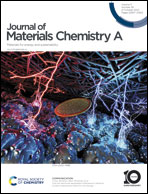Diffusion of bulky organic cations in the 3D/2D heterostructures to form interfacial quasi-2D (N2) phase for tin perovskite solar cells†
Abstract
The fabrication of a solution-processed multilayer (3D/quasi-2D/2D) heterostructure in tin perovskite is complicated and requires an orthogonal solvent system for the sequential layer deposition. Herein, we report the fabrication of multilayered heterojunction perovskite films by physically stacking 3D (E1) and 2D (N1) tin perovskite films with the aid of forceps-induced pressure or external light and heat stimulation. When applying the pressure by forceps or under external stimuli conditions, it would initiate a solid-phase transformation (SPT) to generate a stable new quasi-2D (N2) phase at the interface between 3D and 2D films with the linear chain-type organic cations (butylammonium (BA), hexylammonium (HA), and octyl ammonium (OA)). The mechanism behind the N2-phase formation can be understood as the diffusion of the bulky organic cations across the ion migration barriers to cut the 3D layer with appropriate ion exchange. In contrast, for the bulky aromatic organic cations, such as phenethylammonium (PEA), no SPT occurred to form the N2 phase with the forceps-induced prolonged storage, but the 0D phase can be produced under external stimuli light and heat exposure. Finally, using this approach, a prototypical solar cell device with an E1/N2/N1 configuration was fabricated, which gave a higher PCE (8.7%) than the pristine 3D device (PCE = 7.7%).



 Please wait while we load your content...
Please wait while we load your content...